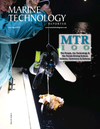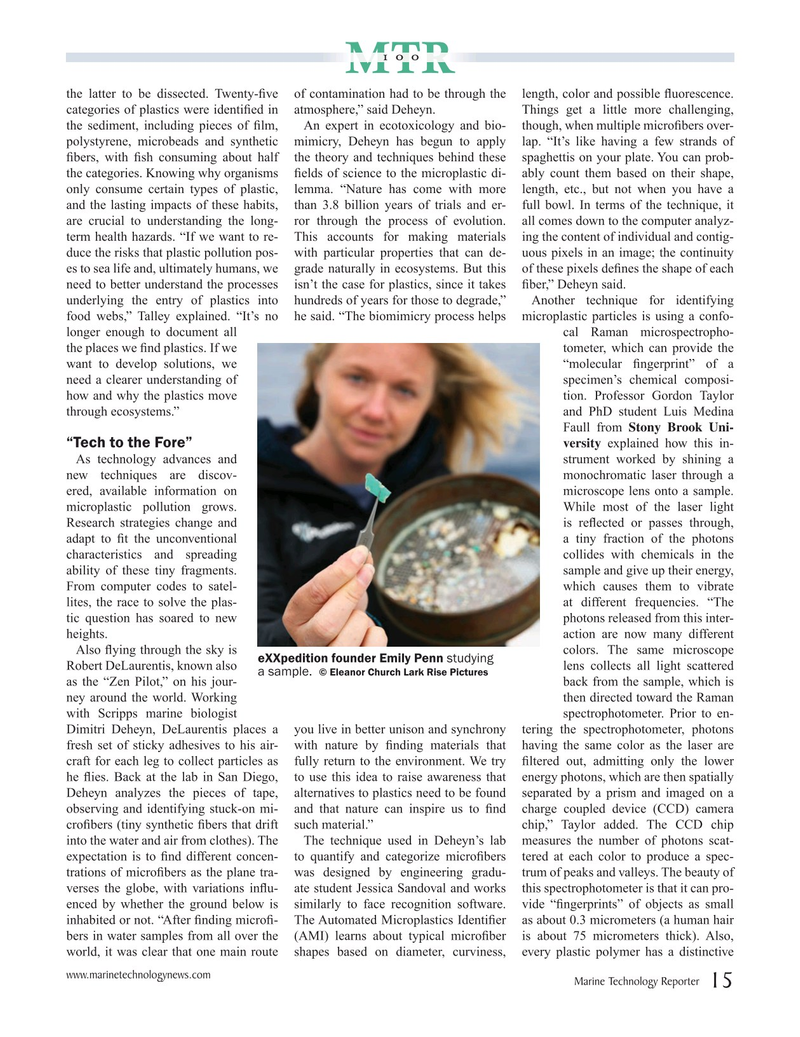
Page 15: of Marine Technology Magazine (July 2020)
Read this page in Pdf, Flash or Html5 edition of July 2020 Marine Technology Magazine
100
MTRMTR the latter to be dissected. Twenty-? ve of contamination had to be through the length, color and possible ? uorescence. categories of plastics were identi? ed in atmosphere,” said Deheyn. Things get a little more challenging, the sediment, including pieces of ? lm, An expert in ecotoxicology and bio- though, when multiple micro? bers over- polystyrene, microbeads and synthetic mimicry, Deheyn has begun to apply lap. “It’s like having a few strands of ? bers, with ? sh consuming about half the theory and techniques behind these spaghettis on your plate. You can prob- the categories. Knowing why organisms ? elds of science to the microplastic di- ably count them based on their shape, only consume certain types of plastic, lemma. “Nature has come with more length, etc., but not when you have a and the lasting impacts of these habits, than 3.8 billion years of trials and er- full bowl. In terms of the technique, it are crucial to understanding the long- ror through the process of evolution. all comes down to the computer analyz- term health hazards. “If we want to re- This accounts for making materials ing the content of individual and contig- duce the risks that plastic pollution pos- with particular properties that can de- uous pixels in an image; the continuity es to sea life and, ultimately humans, we grade naturally in ecosystems. But this of these pixels de? nes the shape of each need to better understand the processes isn’t the case for plastics, since it takes ? ber,” Deheyn said.
underlying the entry of plastics into hundreds of years for those to degrade,” Another technique for identifying food webs,” Talley explained. “It’s no he said. “The biomimicry process helps microplastic particles is using a confo- longer enough to document all cal Raman microspectropho- the places we ? nd plastics. If we tometer, which can provide the want to develop solutions, we “molecular ? ngerprint” of a need a clearer understanding of specimen’s chemical composi- how and why the plastics move tion. Professor Gordon Taylor through ecosystems.” and PhD student Luis Medina
Faull from Stony Brook Uni- “Tech to the Fore” versity explained how this in-
As technology advances and strument worked by shining a new techniques are discov- monochromatic laser through a ered, available information on microscope lens onto a sample. microplastic pollution grows. While most of the laser light
Research strategies change and is re? ected or passes through, adapt to ? t the unconventional a tiny fraction of the photons characteristics and spreading collides with chemicals in the ability of these tiny fragments. sample and give up their energy,
From computer codes to satel- which causes them to vibrate lites, the race to solve the plas- at different frequencies. “The tic question has soared to new photons released from this inter- heights. action are now many different
Also ? ying through the sky is colors. The same microscope eXXpedition founder Emily Penn studying
Robert DeLaurentis, known also lens collects all light scattered a sample. © Eleanor Church Lark Rise Pictures as the “Zen Pilot,” on his jour- back from the sample, which is ney around the world. Working then directed toward the Raman with Scripps marine biologist spectrophotometer. Prior to en-
Dimitri Deheyn, DeLaurentis places a you live in better unison and synchrony tering the spectrophotometer, photons fresh set of sticky adhesives to his air- with nature by ? nding materials that having the same color as the laser are craft for each leg to collect particles as fully return to the environment. We try ? ltered out, admitting only the lower he ? ies. Back at the lab in San Diego, to use this idea to raise awareness that energy photons, which are then spatially
Deheyn analyzes the pieces of tape, alternatives to plastics need to be found separated by a prism and imaged on a observing and identifying stuck-on mi- and that nature can inspire us to ? nd charge coupled device (CCD) camera cro? bers (tiny synthetic ? bers that drift such material.” chip,” Taylor added. The CCD chip into the water and air from clothes). The The technique used in Deheyn’s lab measures the number of photons scat- expectation is to ? nd different concen- to quantify and categorize micro? bers tered at each color to produce a spec- trations of micro? bers as the plane tra- was designed by engineering gradu- trum of peaks and valleys. The beauty of verses the globe, with variations in? u- ate student Jessica Sandoval and works this spectrophotometer is that it can pro- enced by whether the ground below is similarly to face recognition software. vide “? ngerprints” of objects as small inhabited or not. “After ? nding micro? - The Automated Microplastics Identi? er as about 0.3 micrometers (a human hair bers in water samples from all over the (AMI) learns about typical micro? ber is about 75 micrometers thick). Also, world, it was clear that one main route shapes based on diameter, curviness, every plastic polymer has a distinctive www.marinetechnologynews.com
Marine Technology Reporter 15
MTR #6 (1-17).indd 15 8/13/2020 8:40:48 AM

 14
14

 16
16
